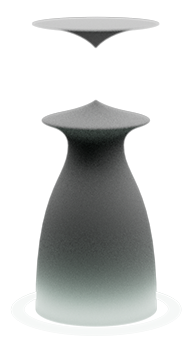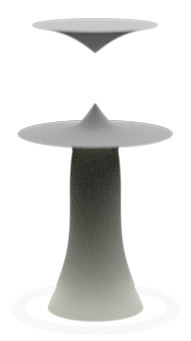




GAIN
Explore the Five Forms by pressing the Power Button (⏻), turning up the Gain,
and selecting a Form with the buttons above.
Or Play the video below to listen to the Passacaglia.

Composer's Note
Channeling the spirit of Duchamp’s Readymades, Five Forms in Parallax is a collection of five instances of pink noise, each sieved through a unique tripartite set of cascading filters to produce five distinct acoustic objets d’art.
Each Form consists of two independent channels of pink noise filtered by a chain of three peak-notch filters in the following configurations:
First Form:
1208Hz 0.6Q -16.9dB
1208Hz 1.8Q 7.9db
13647Hz 2.5Q -5.1dB
Second Form:
354Hz 0.6Q 1.2db
2256Hz 1.8Q 20.9db
5893Hz 0.3Q -45.5dB
Third Form:
131Hz 0.2Q -12.6db
1651Hz 10.4Q 24db
-6644Hz 0.4Q -39.3db
Fourth Form:
207Hz 0.7Q 10.8dB
2256Hz 0.5Q -21.9db
5753Hz 0.7Q -23.9Hz
Fifth Form:
95Hz 0.2Q -40.6db
2800Hz 0.5Q -24dB
15386Hz 0.7Q 13.4db
In addition, each Form slowly oscillates in amplitude over the course of 5 seconds. As this occurs, certain spectral bands are perceived to modulate more greatly than others, giving each Form a greater sense of dimensionality and dynamism and allowing listeners to attend closely to its spectral curves and contours in a kind of aural parallax.
The Forms—presented here using the RNBO add-on for Max—may be listened to in any order and for any duration.
In accompanying video, “Five Forms in Parallax: Passacaglia,” the filter graph for each Form was turned on its side and used as the basis for an outline from which a lathed form was rendered in 3D graphics software. The video provides the listener with short samples of each Form in order from 1 to 5, then looping back to 1, forming a kind of “harmonic progression” or “passacaglia” of noise.
Since the Forms may be listened to in any order and for any duration, “Passacaglia” represents only one way of listening to the work, inviting the listener to engage on their own with the sounds more closely.
Cheers.



